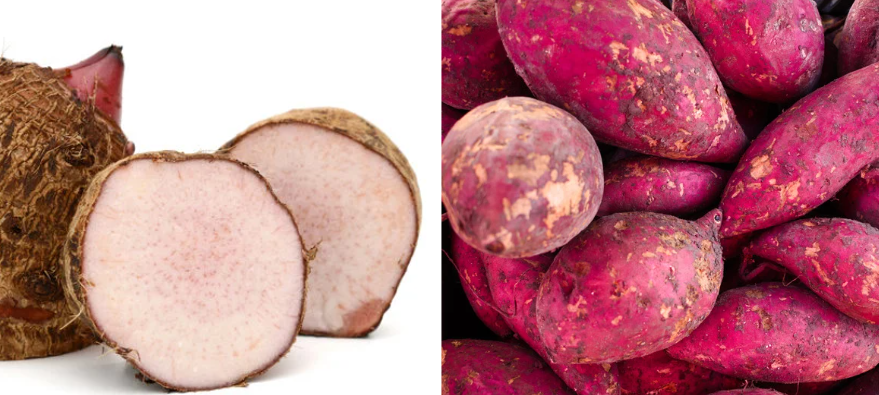Taro Vs. Sweet Potato: Which is better for you?

What To Know
- Sweet potato, on the contrary, has a naturally sweet taste and a creamier texture.
- Taro offers a higher fiber and vitamin C content, while sweet potato provides more vitamin A and iron.
- Store taro and sweet potato in a cool, dark place for up to two weeks.
Taro and sweet potato, two versatile and nutritious tubers, often draw comparisons due to their similar appearance. However, beneath their earthy exteriors lie distinct characteristics that set them apart. This comprehensive guide delves into the differences between taro and sweet potato, exploring their nutritional profiles, culinary uses, and health benefits.
Nutritional Comparison: A Battle of Vitamins and Minerals
Carbohydrates and Fiber
Both taro and sweet potato are rich in carbohydrates, providing a sustained source of energy. However, taro contains slightly more fiber, which promotes satiety and digestive health.
Vitamins
Taro excels in vitamin C content, a powerful antioxidant essential for immune function. Sweet potato, on the other hand, boasts higher levels of vitamin A, vital for vision and skin health.
Minerals
Taro is a good source of potassium, which supports blood pressure regulation. Sweet potato is notably richer in iron, an essential mineral for red blood cell production.
Culinary Delights: Exploring Versatile Flavors
Taste and Texture
Taro has a mild, slightly nutty flavor and a starchy texture when cooked. Sweet potato, on the contrary, has a naturally sweet taste and a creamier texture.
Cooking Methods
Taro is commonly boiled, steamed, or fried, while sweet potato excels in roasting, baking, or mashing. Both tubers can be incorporated into soups, stews, and curries.
Global Cuisine
Taro is a staple ingredient in many Asian dishes, such as taro soup and taro bubble tea. Sweet potato is widely used in American cuisine, particularly in pies, fries, and casseroles.
Health Benefits: Uncovering Therapeutic Properties
Anti-Inflammatory Effects
Taro contains anti-inflammatory compounds that may help reduce the risk of chronic diseases. Sweet potato is also known for its anti-inflammatory properties, attributed to its high beta-carotene content.
Blood Sugar Control
Taro’s high fiber content slows down the absorption of sugar into the bloodstream, making it a suitable food for individuals with diabetes. Sweet potato has a lower glycemic index than regular potatoes, providing a more sustained release of energy.
Immune Support
Taro’s abundance of vitamin C strengthens the immune system, protecting against infections. Sweet potato’s beta-carotene is converted to vitamin A in the body, which supports immune function.
Taro vs Sweet Potato: A Summary of Key Differences
| Feature | Taro | Sweet Potato |
| — | — | — |
| Taste | Mild, nutty | Naturally sweet |
| Texture | Starchy | Creamy |
| Vitamin C | Higher | Lower |
| Vitamin A | Lower | Higher |
| Potassium | Higher | Lower |
| Iron | Lower | Higher |
| Fiber | Higher | Lower |
| Common Cooking Methods | Boiling, steaming, frying | Roasting, baking, mashing |
The Verdict: A Matter of Personal Preference
Ultimately, the choice between taro and sweet potato depends on personal preferences and dietary needs. Taro offers a higher fiber and vitamin C content, while sweet potato provides more vitamin A and iron. Both tubers are versatile and nutritious, making them valuable additions to a healthy diet.
Beyond Comparison: The Unique Benefits of Each Tuber
Taro: The Lesser-Known Superfood
Taro’s high fiber and vitamin C content make it a standout choice for promoting digestive health and immune function. Its mild flavor and starchy texture allow it to blend seamlessly into various dishes, from soups to desserts.
Sweet Potato: The Versatile Health Superstar
Sweet potato’s exceptional vitamin A and iron content make it a nutritional powerhouse. Its naturally sweet taste and creamy texture make it a popular ingredient in both savory and sweet preparations.
Quick Answers to Your FAQs
1. Can taro and sweet potato be eaten raw?
Taro should not be consumed raw due to the presence of raphides, needle-like crystals that can cause irritation. Sweet potato can be eaten raw in small amounts, but cooking enhances its flavor and digestibility.
2. How do I store taro and sweet potato?
Store taro and sweet potato in a cool, dark place for up to two weeks. Avoid refrigerating, as low temperatures can damage the tubers.
3. What are some creative ways to cook taro and sweet potato?
Try using taro in stir-fries, soups, or as a thickener for sauces. Sweet potato can be roasted, mashed, or made into fries, chips, or pies.